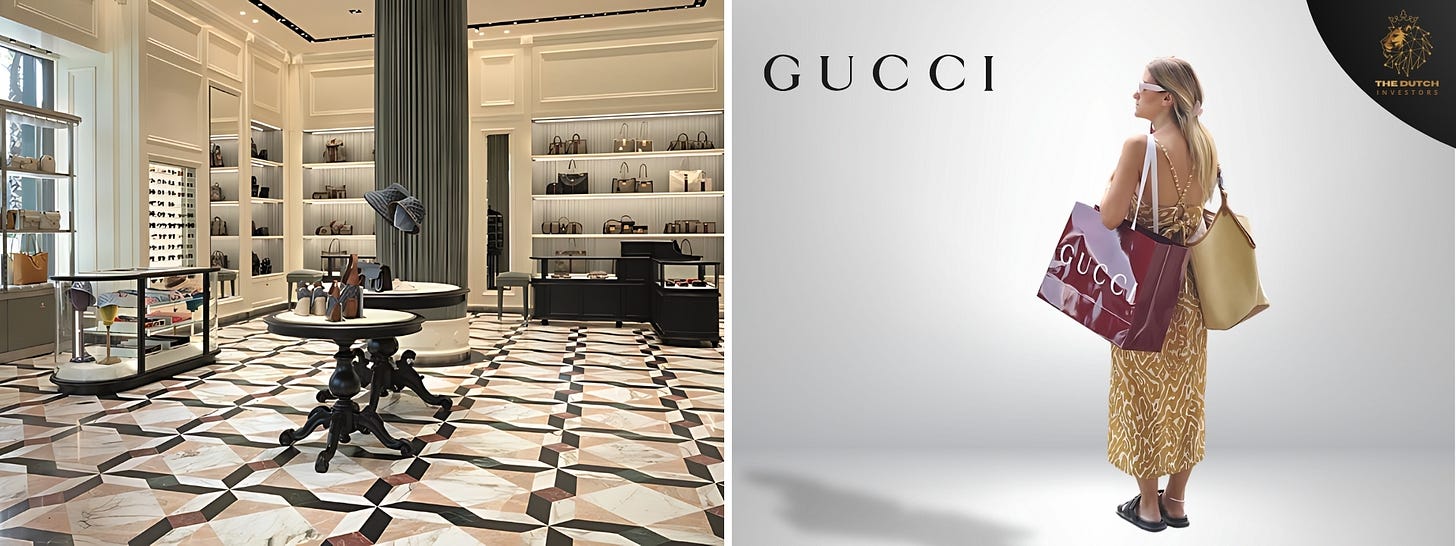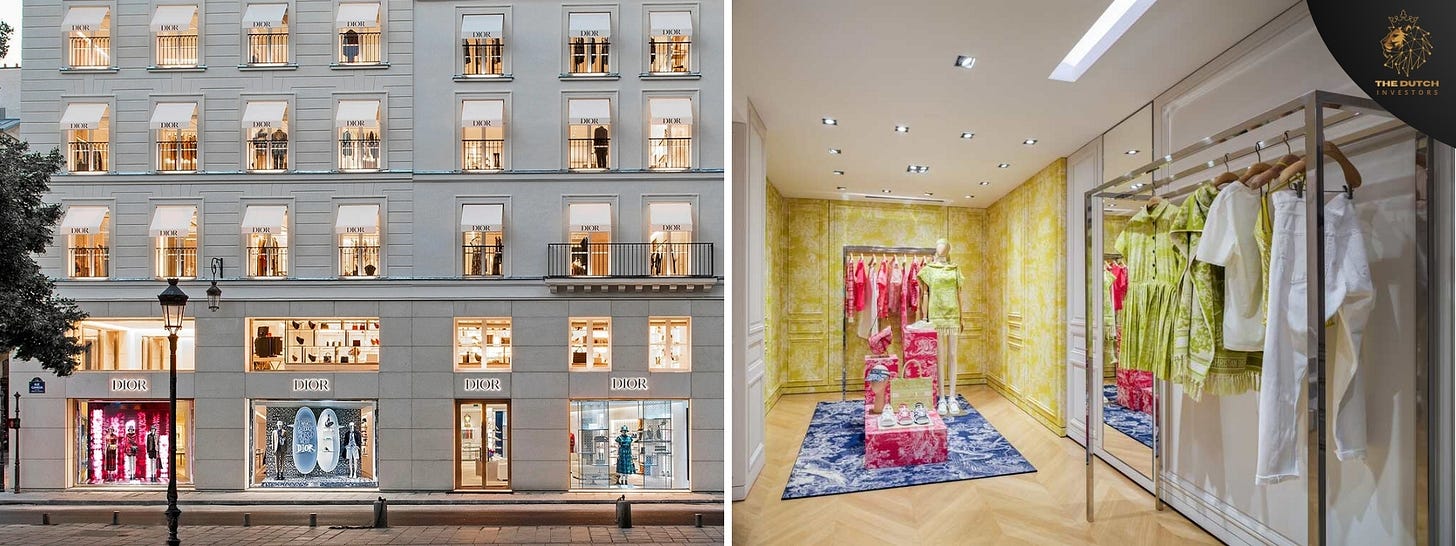We visited Hermès, Gucci, Dior, and Louis Vuitton stores in Athens
On our holiday we went to Hermès, Louis Vuitton, Gucci and many more. Find out more about the luxury industry and relevant insights about these luxury brands.
During my vacation in Athens, I couldn't resist using my time to understand the luxury industry better and study luxury brands. So, I spent a few days visiting as many luxury stores as possible, from Hermès to Louis Vuitton, and from Gucci to Cartier. Despite the scorching heat in Athens, I managed to gather some new insights about the luxury stores there.
My girlfriend and I took an Uber to the luxury district of Athens: Kolonaki. One thing that stood out immediately, which many of you probably already know, is that all these luxury brands prefer to be close to each other. This creates a feeling of a luxury neighborhood, a special part of the city just for the elite and wealthy. There were many 'aspirant' customers (people who are interested in luxury or find it beautiful and perhaps want to buy something small), many 'window shoppers' (people who look but don't buy), and actual customers planning to make one or more purchases.
I want to add some structure to this 'personal luxury experience' document, so I'll discuss the companies individually, sharing my observations, opinions, and some (new or well-known) insights. I focused on several things: discounts, sales methods (push-pull principle), store atmosphere and feeling, and story building.
Hermès
Let's start with the crème de la crème: Hermès. As always, this stunning store was located on the corner of the street. You could see the brand and the magnificent building right from the road. I waited here for 45 minutes in the scorching heat of 39 degrees Celsius until my friend said, "Okay, I really can't take this anymore, I want to go." Although this was painful (you want to see it through), it did give me some interesting insights.
People, whether repeat customers or not, sometimes had to wait 60 minutes outside just to get into the store. Once inside, an employee personally assisted each customer. All employees were exquisitely dressed with the famous orange scarf. A well-dressed doorman guarded the door. The store door was entirely bulletproof glass and only opened for exiting or new customers. I found it fascinating to see how long people were willing to wait in this heat (39 °C) for a closed door. Hermès clearly used the push principle, adhering to the "less is more" philosophy, where the scarcity of products and the exclusivity of the shopping experience drive demand. Each purchase feels more special and exclusive thanks to this approach.
Naturally, there were no discounts at Hermès. There were about 5–7 people in the Hermès store. I made my 45-minute wait somewhat useful by asking them a few questions.
How often do you visit Hermès?
I received various answers to this question. Some customers visited Hermès multiple times a year for special occasions or seasonal collections, while others came less frequently, maybe once or twice a year, but made larger purchases. Every single customer had bought something at Hermès before. Every single person who left the Hermès store had bought something. (At least that’s what I concluded after seeing 9 people leave with a bright orange bag…)
Why do you choose Hermès over other stores?
Many wealthy customers said they chose Hermès because of the exceptional quality, craftsmanship, and timeless elegance of the products. They liked the fact that Hermes was not as flashy as, say, Gucci or Louis Vuitton. ‘It’s more subtle’, someone said.
I think that many customers, even if they don't say it, come for the status and feeling it gives. They mentioned that the service was unparalleled, they felt special when inside, and the quality was unmatched.
What do you do for a living?
This might seem like a strange question, but I was curious about what kind of people buy Hermès items. The professions I found in the waiting line included: entrepreneurs (3), an eye doctor (1), a lawyer (1), a bank manager (1), and a software engineer. There was also a lady who was still studying, so I suppose she must have very ‘supportive’ parents, as she walked out of the Hermès store with a large orange bag after about 30 minutes. Can we conclude anything from this? Not really, except that all these professions (potentially) earn considerably more than average jobs.
When you go to a Hermès store, do you already know what you want to buy?
Customers gave different answers to this question. Some knew exactly what they wanted to buy, like a wallet, bag, scarf, or belt. Other customers came to the store to get inspired by the latest collections and seek advice from the staff. They looked around and bought something if it appealed to them.
Louis Vuitton
Like almost all the other stores, Louis Vuitton was also beautiful from the outside, with some decorative pieces and a display of iconic LV bags. The exterior design serves as a powerful visual marketing tool, drawing in potential customers with its opulent and inviting appearance. At LV, you could just walk in. No long lines, no doorman, or closed door. This approach contrasts with some other luxury brands, reflecting Louis Vuitton's more inclusive luxury strategy. This was also reflected in the busyness inside. At Hermès, there were only 6–8 customers in the store, each being personally assisted.
At LV, you were free to walk around, admire everything, and, of course, receive friendly assistance if you had questions or needed help. Customers were subtly encouraged by the staff to buy something. Hermès clearly used the push principle, less is more, but at LV, you saw more of a pull principle. There were no discounts to be seen. There were about 20 people in the LV stores.
Gucci
The Gucci store was almost identical to that of LV, not in layout or assortment, but in atmosphere, service, and how customers were treated. In both Hermès, LV, and Gucci, there were more female customers than male customers. This could be a coincidence, but it stood out.
It was beautiful how the employees took customers into the story behind the products and showed in detail why this was a great product. I never experienced an employee trying to push a product to sell it. They were patient and adjusted to what the customer wanted if they weren't completely content. There was no push principle, customers were gently introduced to the heritage and story of the Gucci products, step by step, leading to a sale. There were no discounts to be seen. There were about 15 people in the Gucci stores at one time.
We’ve actually done a deep dive into the parent company, Kering. Click here.
Dior
The Dior store had a stunning exterior that was both modern and classic. The display featured models wearing the latest Dior clothing with dazzling designs. My girlfriend particularly found Dior to stand out, as she mentioned later that day. She described it as having a 'feminine' and elegant ambiance. She also thought the Dior designs were beautiful.
Inside, the atmosphere was refined and luxurious. There was no queue. The layout was spacious, allowing for comfortable browsing. It was significantly busier and larger than the other stores. When I was there, there were at least 20 women inside (and 10 reluctantly accompanying men). There were no discounts to be found.
Attika
In the Netherlands, we have the Bijenkorf, a department store concept with a wide range of premium and luxury brands. In Athens, this department store is called Attika. Inside, you can find dozens of different brands such as Polo Ralph Lauren, Hugo Boss, Balenciaga, Chanel, Gucci, Giorgio Armani, and even Crocs, alongside more renowned luxury brands like Yves Saint Laurent, Dior, and even Hermès.
You might wonder why these luxury brands are mixed with premium brands. In our Kering and Richemont analysis, we explained the different levels of luxury (ultra-luxury, high-end luxury, accessible luxury, niche luxury, and premium). In a Bijenkorf or Attika, these brands from different levels are all intermixed. You'll mainly find accessible luxury and premium brands, but you can also find high-end and ultra-luxury items. This is quite peculiar. These brands go to great lengths to be 'different' from the rest, yet they all reside under the same roof.
I believe there is a good reason for this. Before I visited, my theory was that 'real' luxury brands like Dior, Hermès, Gucci, and Louis Vuitton only sell 'smaller' products in department stores, which they (often) outsource to other companies. This includes items such as sunglasses, makeup, or perfumes. Even Hermès, known for its extreme exclusivity, is heavily promoted here. Not the bags, but the fragrances.
Why is that? I believe it is to give consumers a 'taste' of luxury brands. Chanel or Giorgio Armani do not produce their own sunglasses or perfumes but outsource these to companies like EssilorLuxottica, which manufacture these products for them. In the case of LV and Gucci, they produce a significant portion of the eyewear themselves, but the goal remains the same: to familiarize consumers with their brand and quality. It is cheaper than the clothing and bags they primarily focus on.
You can see it as a form of marketing without traditional advertising. In these department stores, there is a stronger 'pull effect,' where various brands, including Hermès, appeal to you and invite you to try or view their products.
Funny enough, almost every single brand used discounts to promote and sell more. From Hugo Boss to Polo Ralph Lauren, Yves Saint Laurent and Michael Kors.
The only brands that did not offer any discounts were Dior, Chanel, Moncler, Gucci, and Hermès. That means something, right?
Closing thoughts
Let me just summarize a few key insights and concepts that I’ve seen and learned after researching the luxury industry the past few months. Some of these I’ve seen and experienced during my field research.
Luxury brands target high-net-worth individuals (HNWI) and aspirational consumers who are willing to pay a premium to own exclusive, high-quality products.
Luxury brands must create a sense of exclusivity to attract their target audience.
Luxury brands leverage their high prices to create a prestigious image.
Luxury marketing is based on the 4 E’s by Michel Chevalier: emotion, exclusivity, experiences, and extension of brand value.
Luxury brands cannot be formally defined as an independent industry, as the goods and services produced by such brands vary from automobiles to wristwatches.
There are three types of luxury consumers: “luxury eaters”, “luxury regulars”, and “luxury nibblers.” We’ll go more in-depth in a future article on this specific topic.
Discounts are not a good sign for a premium or luxury brand. It strongly suggests that the brand has limited pricing power and/or is trying to boost sales by increasing quantity (which can also be a negative sign)
What should you do with all this information? That depends on the person. I can imagine that for many people, this information is already known, while others might have learned something new. I hope, in any case, that you found it interesting and (hopefully) read something new.
I thoroughly enjoyed bringing theory into practice. I find investing to be one of the most beautiful things in life, and seeing the theory and companies in practice makes investing come to life even more. They become real companies instead of just stocks.
Investing is truly beautiful.









Cool stuff, thanks for reporting back to us.